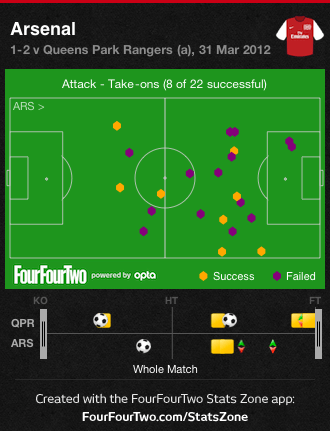If this is the Golden Era of the prolific front men, then you might want to spare a thought for their back-ups. Because it’s they that have to suffer the most, having to sit and watch as each goal from the main striker further condemns to a bit-part role. Indeed, with the prevalence of the lone striker system in the modern game, it means only one can start. For Manchester United fans, that meant having to sit through last season perplexed as to why Dimitar Berbatov rarely figured while even the relatively prolific Javier Hernandez (10 goals in 21 starts) had to play second fiddle to Danny Welbeck because he created space better for the chief goal-getter, Wayne Rooney. At other clubs around Europe, it was a similar scenario: Lionel Messi’s exploits meant Barcelona went most of the season without an orthodox striker; Lucas Barrios only started three games at Borussia Dortmund despite top scoring the season before while Arsenal fans have seldom seen Marouane Chamakh and Park Chu-Young warm up, let alone enter the play. And in the forthcoming European Championships, both France and Germany have decided to pack their sides with creative midfielders and enter the tournament with only two strikers.
It’s not such an obvious choice up front for Netherlands, however, as they can call on the third and fourth top-scorers in Europe respectively, Robin van Persie (30 goals) and Klass-Jan Huntelaar (29 goals). Indeed, the decision to which of the strikers has been the main talking point in the lead up to Euro 2012. Huntelaar impressed in qualifying with 12 goals but the signs are van Persie will get the nod despite never quite convincing in the orange – it’s his fourth major tournament as a starter. But if van Persie is assured of a place in the line-up come the opener against Germany, it’s because the normally cautious Bert van Marwijk has decided give the Arsenal striker the support – on the pitch – that he so desperately craves.
The Holland manager, in van Persie’s words, has said that he “will go for a striker who works well with the midfield,” but stopping short of virtually confirming that he will start, van Persie added: “But that can also be Klaas.” And the slight tactically change – mainly decided upon by the unique skills of the personnel at his disposal rather than any ideological shift – suits van Persie more. “Robin is an all-round attacker, but he showed he is also a killer in the box,” said van Marwijk. “Klaas-Jan is a goal-getter and is always getting better with the squad.”
The new approach was indicated in the 6-0 thrashing of Northern Ireland where Robin van Persie created and scored two goals and in particular, linking superbly with Ibrahim Afellay. Indeed, unlike Rafael van der Vaart or Wesley Sneijder beforehand perhaps, convincing Afellay to use his skill on the left is probably the final piece of van Marwijk’s puzzle. It allows Afellay to cut in his stronger foot and create but most importantly, to link up with the forward. Because with van Marwijk’s 4-2-3-1 system, there’s a distinct 6-4 split between defence and attack and thus, a lot relies on the front four to produce. As such, having an extra creator in the line-up instead of the hard-working Dirk Kuyt allows van Marwijk to go with two holding midfielders. “At the World Cup, we played large parts of games in our opponents’ half,” said the manager. “That means you need to be very patient, because if you force yourself too much – and we know the level of football at the Euros – then you know you will face dangerous counterattacks, and we don’t want that.”
The set up should fuel Robin van Persie’s instincts; spontaneity is his greatest asset, yet those impulses haven’t been rewarded in the international stage. He complains about the lack of service he received in South Africa 2010, indirectly criticising the role of Wesley Sneijder. “However hard I find it to accept, I wasn’t on top of my game,” he told Henk Spaan in FT Magazine. “In the whole World Cup, I was only put [through] in front of the keeper four or five times. Cesc [Fabregas] did it four or five times a match.” The two have made up since then and the signs were good when Sneijder put through van Persie in the 2-1 warm-up defeat to Bulgaria. Indeed, Van Persie tells Spaan of the unique relationship between the team’s playmaker and the striker that that they have to “form a two-in-one unit” and it’s notable that for Arsenal last season, van Persie’s goalscoring really accelerated when Aaron Ramsey was push closer to him in attack. And later on in the season, his understanding with Tomas Rosicky (and the impact of Yossi Benayoun) seemed to be the only thing pushing Arsenal over the line.
Many feel that this might be Robin van Persie’s zenith moment – and not just Arsenal fans who anxiously wait with the belief that the tournament holds the key to his future. Ajax analyst and friend of Johan Cruyff, Tonnie Bruins Slot, feels van Persie can emulate the legendary striker with his interpretation of the no.9 role. “Johan always started as the team’s forward, and then dropped a bit deeper to direct play, and create space for wingers like Rob Rensenbrink and John Rep, and midfielders such as Wim van Hanegem and Johan Neeskens,” Tonnie Bruins Slot told De Telegraaf. “This indirectly led to the ‘Totaalvoetbal’ Oranje played at the 1974 World Cup. Van Persie can play a similar role this summer, and it looks like [national team coach] Bert van Marwijk intends to use him like that.”





















